
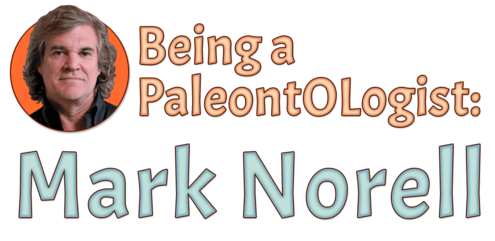
Drawn by the adventure of fossil hunting, Mark Norell became a paleontologist and has gone on expeditions year after year. Find out what it’s like to look for and collect fossils in the field, and why Mark enjoys research back in the lab even more.
1. Were you interested in dinosaurs as a kid?
Mark Norell: No, but I was always interested in science. In college and graduate school, I worked a lot with fossils of crocodiles, lizards, that sort of thing. When I came to the Museum, I was studying how DNA influences the way plants and animals develop. At the Museum, it just seemed natural to get involved with dinosaurs because we have one of the world's greatest collection of dinosaur fossils. To tell you the truth, it's more the unanswered questions about dinosaurs that interest me rather than the dinosaurs themselves.
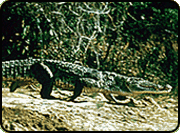
Mark studied fossils of crocodiles and lizards in college.
2. What do paleontologists do?
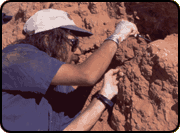
Mark uncovers a specimen in the Gobi desert. Then, he spends a lot of time studying it in the lab.
Mark: Many people think that paleontologists spend all their time in far-off places, collecting every fossil they find, and bringing them back to a museum to put them on display. All the Indiana Jones stuff. But, that's really only a small part of what we do. We only spend a few weeks a year on expeditions. The rest of the year we are in our labs looking at what we found. We spend a lot of time classifying specimens, looking at their characteristics and how they are related to each other. I spend more time on the computer than I do in the field.
3. Do you bring back all the fossils that you find?
Mark: Definitely not! First of all, when we go in the field, we are usually looking for specific fossils to help us answer specific questions. For example, we collect many theropod specimens, which are carnivorous dinosaurs. Any theropod fossils we find are important to our research on the origin of birds. Since birds and ancient dinosaurs are all theropods, they are closely related to each other. Actually, we don't keep any of them. We work with scientists at the Mongolian Academy of Sciences. All the fossils we find in the Gobi desert belong to them. They are only on loan to us.
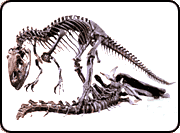
The theropod Allosaurus from a mount in the Museum's exhibition hall.
4. Are most of the fossils you've found on display at the Museum?
Mark: Some of the specimens I've collected have made it into the halls, but most are used for research. Our collection of specimens is like our library. We look at the specimens again and again to help us answer questions. For example, scientists on my staff use the specimens in the collection for their research on topics such as lizard, dinosaur, and mammal evolution (how these animals have changed over time).
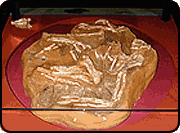
A nesting oviraptorid specimen in the Museum's collection.
5. What about your job is most enjoyable?
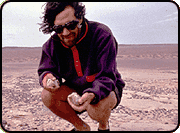
Mark examines some finds in the Gobi.
Mark: Well, like most people, I was originally drawn to this kind of work by the adventure and the opportunity to travel to very remote and exotic locations. And, no doubt, the expeditions are certainly fun. But, the part of the work I like doing best is the science research in labs, working on specimens.
6. Are there any down sides to being a paleontologist?
Mark: Well, every job has some hassles. Expeditions and research are great fun, but you have to raise money. To run an expedition is very expensive. Think about what's involved! You need money for airfare and vehicles to get you to the location, equipment, food, salaries for your team members, and the cost of flying the specimens home. Then, there's the cost of preparing the fossils in the labs once we've brought them back. But, even with these hassles, my job is still so exciting.
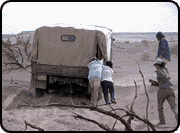
A sandstorm: one of the many hassles of doing fieldwork in the Gobi.
7. Why do you go on expeditions to Mongolia every summer?
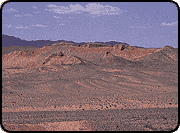
The fossil-rich red hills of the Gobi desert.
Mark: It's probably the best place in the world to find dinosaur fossils that we have questions about. These fossils are evidence of the transition between what people have always called dinosaurs and what people call birds. So, thanks to our expeditions in Mongolia , we now know that animals like Velociraptor and other small carnivorous dinosaurs are related to birds.
8. Are you the first paleontologists to go to Mongolia?
Mark: Oh no! There's a long tradition of collecting dinosaur fossils in central Asia starting in the 1920s. But politics interfered with science. Those expeditions stopped in the mid-1920's because of political problems. Mongolia is part of China. Mongolia became a communist country in 1920, and soon after, they would not permit Western paleontologists to work there. Many years later when relations between the United States and China began again, the Museum was invited to come back. Since 1990, we've been going to Mongolia every summer to search for fossils.
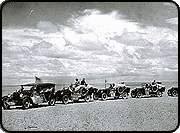
The Central Asiatic Expedition's caravan in 1921.
9. Where would you like to go on an expedition that you've never been to?
Mark: I would love to go and search for fossils in Iran and Afghanistan. It has not been explored in a long time. It's just the right kind of landscape to hold preserved fossils, as this stable area of the continent has not been subjected to many major geological events that destroy fossils. But again, politics is in the way of science. There have been wars in those areas in recent years.
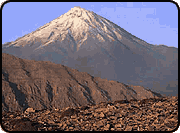
The plateau of Iran with Damavand peak seen in the background.
10. What's a typical day like on an expedition?
Mark: Usually, we get up in the morning, eat breakfast and decide what we're going to do, then we pack our stuff and go out fossil hunting. On a good day, we find some fossils. On a great day, we find fossils that we didn't expect to find. On a bad day, we waste time repairing our trucks or hiding from sandstorms. After a long day of work, we all get together each night for a group dinner. Everyone pitches in, collecting wood for the fire, opening cans, preparing the food, and cooking. After dinner we talk about the day, play music, and stargaze.
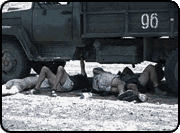
Expedition members take a break in the shade from the Gobi heat.
11. On an expedition, how do you know where to dig for fossils?
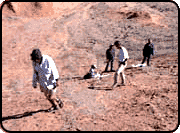
Mark and the team spend many hours scouring the ground for traces of fossilized bone.
Mark: Finding the right spot takes lots of experience and luck. Before we go, we research the place we're planning to dig to about the age and type of the rocks. At the site, we spend many hours looking for bits of exposed bone. When we think we've found a specimen, we carefully explore the area using dental tools and small brushes. If we think we've found something, then our excavation team comes to help us. We usually cut out a large piece of rock with the fossil inside it, so we don't damage the fossil. Then, we transport it back to the Museum to prepare it for research.
12. When you're on an expedition in the desert, do you sleep in a tent?
Mark: A tent? Please! I hate the hassle of a tent, especially if they get wet. I like to sleep under the stars. I rarely use a sleeping bag. At night, I usually sleep in the dirt on a pad made of Mongolian camel-hair. When we're on an expedition, I like to rough it as much as possible. Over a five week period, I usually bathe maybe twice, and change my clothes once. Sometimes our clothes get so filthy we have to burn them. Even though we sometimes walk more than twenty miles a day, I'd rather wear sandals than boots. Why? I hate smelly socks. They're a waste of space and energy.
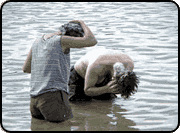
Some expedition members take advantage of a lake to catch up on some bathing.
13. How's the food on the expeditions?
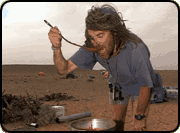
The expedition team is lucky because Mark is a skilled and enthusiastic cook.
Mark: We eat really well. I like to cook and plan the meals. We ship most of our food from Los Angeles, which is our last stop in the United States. We eat a lot of Mexican and Thai food, and bring giant wheels of cheese and huge hams. We also eat shrimp, eels, and squid. We even make my favorite food, sushi.
14. What's the first thing you do when you return from the Gobi desert?
Mark: I think all scientists are alike in this. I take a long, hot shower. Sometimes, I take two or three to get all the dirt off. And I eat lots of fresh vegetables. Then, I get on a long plane ride and sleep, resting up to see my family.
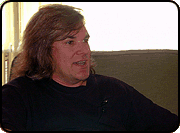
Mark, all cleaned-up, back in his office in New York.
15. What does a fossil preparator do?
Mark: Amy Davidson is a fossil preparator who I work closely with at the Museum. She also comes with us to the Gobi desert each year. Amy prepares the fossils for study by removing them from the rock and cleaning them. This is an important job that requires a lot of skill and patience. Remember that all we find is fossilized bone. Most of the pictures you've seen of dinosaur skeletons fossils are taken after a preparator has spent many hours gently removing the skeleton from rock. Amy's background is in sculpture, and she uses her artistic training every day as she prepares fossils. Art is very important to science, but especially to paleontology.
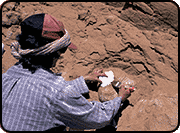
Museum fossil preparator Amy Davidson prepares a fossilized specimen for removal from the rock where it was discovered.
16. How do you identify dinosaurs you find?
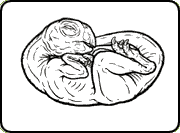
A drawing by Museum illustrator Ed Heck, showing how an oviraptorid embryo may have looked curled up in its shell.
Mark: After we get a specimen to New York, it is cleaned and prepared by a team of technicians. Then our research group begins to describe it. Description means just what you think, only very detailed. We draw pictures, measure, count bones, and describe in words. It takes time to describe a specimen, especially if it is a fossil that has never been seen before. After we describe a specimen, we name it. The description is then published in a scientific magazine called a journal, so other scientists can learn about what we've found.
17. What do the fossil specimens you find tell you about dinosaurs?
Mark: We always compare a new specimen with other known animal skeletons and try to figure out where they fit in our family tree of dinosaurs. This helps us figure out how different dinosaurs were related to each other. The family tree diagram we use at the Museum is called a cladogram . If you go to Beyond T. rex, you will see how it works. As we work with a new specimen, we begin to understand lots of different things about it, such as how the bones might have worked mechanically or how big the animal might have been.
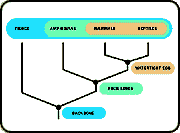
A simple cladogram that shows the relationship between vertebrates and tetrapods and amniotes.
18. How do you use computers in your work?
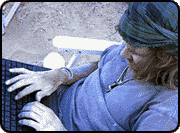
Mark at work on his computer in the field.
Mark: In some ways, we dig more with a mouse than a pick. Computers play a crucial role in paleontology these days. For example, we now have thousands of images of specific fossils from all over the world, which makes our research much easier. We also use computers to help us examine patterns in the family trees of dinosaurs, so we can see how dinosaurs are related to each other. Another important way we use computers is to CAT scan fossils that are inside rocks. This gives us a digital pictures of a fossil without having to remove it from rock, which could damage it. CAT scans are used by doctors to see inside the human body. The way a CAT scan works is to take lots of very thin "X-ray" pictures of a chunk of rock that contains a fossil. Imagine a loaf of bread sliced into very thin pieces. Each "X-ray" slice of the specimen has a thickness of about 100th of a millimeter. That's not even as big as the period on the end of this sentence. Afterward, we assemble all those slices together in the computer and assemble a 3-D digital picture of the whole fossil.
19. Aside from the Museum, where do paleontologists find jobs?
Mark: Paleontologists find jobs at universities, and sometimes work for the Federal Government in the National Park Service, the U.S. Geological Survey, or the Bureau of Land Management. A few paleontologists are freelance paleontologists.
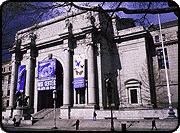
The American Museum of Natural History in New York.
Image Credits:
All photos courtesy of AMNH.




 Biodiversity
Biodiversity
 Brain
Brain
 Genetics
Genetics
 Marine BiOLogy
Marine BiOLogy
 MicrobiOLogy
MicrobiOLogy
 PaleontOLogy
PaleontOLogy
 ZoOLogy
ZoOLogy
 AnthropOLogy
AnthropOLogy
 ArchaeOLogy
ArchaeOLogy
 Astronomy
Astronomy
 Climate Change
Climate Change
 Earth
Earth
 Physics
Physics
 Water
Water
